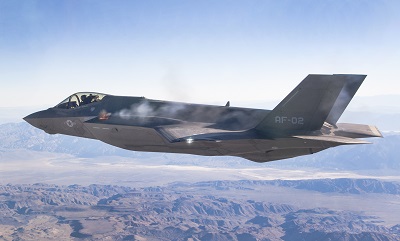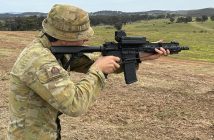
![]() The F-35A Lightning II completed the first three airborne gunfire bursts from its internal Gun Airborne Unit (GAU)-22/A 25mm Gatling gun system during a California test flight, Oct. 30. This milestone was the first in a series of test flights to functionally evaluate the in-flight operation of the F-35A’s internal 25mm gun throughout its employment envelope.
The F-35A Lightning II completed the first three airborne gunfire bursts from its internal Gun Airborne Unit (GAU)-22/A 25mm Gatling gun system during a California test flight, Oct. 30. This milestone was the first in a series of test flights to functionally evaluate the in-flight operation of the F-35A’s internal 25mm gun throughout its employment envelope.
Three bursts of one 30 rounds and two 60 rounds each were fired from the aircraft’s four-barrel, 25-millimeter Gatling gun. In integrating the weapon into the stealthy F 35A airframe, the gun must be kept hidden behind closed doors to reduce its radar cross section until the trigger is pulled.
F-35A test aircraft AF-2, a loads-instrumented jet, underwent an extensive structural modification at Edwards Air Force Base, Calif. to a fully production representative internal gun configuration. The first phase of test execution consisted of 13 ground gunfire events over the course of three months to verify the integration of the gun into the F-35A. Once verified, the team was cleared to begin this second phase of testing, with the goal of evaluating the gun’s performance and integration with the airframe during airborne gunfire in various flight conditions and aircraft configurations.
“The successful aerial gun test sortie was a culmination of several years’ planning, which intensified in the first half of 2015 at the Edwards F-35 Integrated Test Force (ITF) Flight Test Squadron with a team of Air Force, Lockheed Martin, Pratt & Whitney, General Dynamics, and Northrop Grumman personnel,“ said Mike Glass, Edwards ITF flight test director. “The results of this testing will be used in future blocks of testing, where the accuracy and mission effectiveness capabilities will be evaluated.”
The 25mm gun is embedded in the F-35A’s left wing and is designed to be integrated in a way to maintain the F-35’s very low observable criteria. It will provide pilots with the ability to engage air-to-ground and air-to-air targets. The first phase of F-35 gun testing started in June, when initial shots were fired from the ground at the Edwards Air Force Flight Test Center’s gun harmonizing range.
The gun system will be further tested with a production F-35A next year for integration with the jet’s full mission systems capabilities. The test team will demonstrate the gun’s effectiveness in both air-to-air and air-to-ground employment when integrated with the next generation fighter’s sensor fusion software, which will provide targeting information to the pilot through the helmet mounted display. At the end of the program’s system development and demonstration phase in 2017, the F-35 will have an operational gun.
The F-35 Lightning II is a low observable family of stealth fighters being developed for the U.S. Air Force, U.S. Marines, U.S. Navy, and 11 international countries. More than 160 production F-35s have been delivered and the aircraft have flown more than 42,700 flight hours, fleet-wide.






